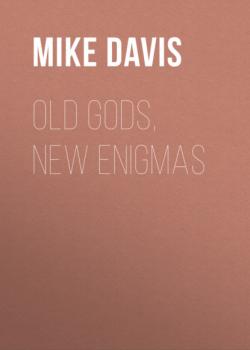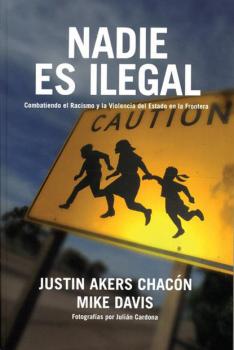ТОП просматриваемых книг сайта:
Mike Davis
Список книг автора Mike DavisАннотация
Old Gods, New Enigmas is the highly-anticipated book by the best-selling author of City of Quartz and Planet of Slums . Mike Davis spent years working factory jobs and sitting behind the wheel of an eighteen wheeler before his profile as one of the world’s leading urbanists emerged with the publication of his sober, if dystopian survey of Los Angeles. Since then, he’s developed a reputation not only for his caustic analysis of ecological catastrophe and colonial history, but as a stylist without peer. Old Gods, New Enigmas is Davis’s book-length engagement with Karl Marx, marking the 200th anniversary of Marx’s birth and exploring Davis’s thinking on history, labor, capitalism, and revolution – themes ever present the early work from this leading radical thinker. This will be his first book on Marxism itself.
Аннотация
This new volume in the concise «How To» series explores the foundations and principles of continuing education of professionals and then relates these to the practice of teaching the various modalities used in CME. The areas covered include experiential learning, group dynamics, situated learning and reflective practice – and make these understandable for all health professionals tasked with teaching continuing medical education. An ideal introduction to teaching for clinical instructors.
Аннотация
History of the car bomb traces the political development of this influential weapon of terror and resistance. In this provocative history, Mike Davis traces the car bomb's worldwide use and development, in the process exposing the role of state intelligence agencies—particularly those of the United States, Israel, India, and Pakistan—in globalizing urban terrorist techniques. Davis argues that it is the incessant impact of car bombs, rather than the more apocalyptic threats of nuclear or bio-terrorism, that is changing cities and urban lifestyles, as privileged centers of power increasingly surround themselves with 'rings of steel' against a weapon that nevertheless seems impossible to defeat..
Аннотация
Examining a series of El Niño-induced droughts and the famines that they spawned around the globe in the last third of the 19th century, Mike Davis discloses the intimate, baleful relationship between imperial arrogance and natural incident that combined to produce some of the worst tragedies in human history. Late Victorian Holocausts focuses on three zones of drought and subsequent famine: India, Northern China; and Northeastern Brazil. All were affected by the same global climatic factors that caused massive crop failures, and all experienced brutal famines that decimated local populations. But the effects of drought were magnified in each case because of singularly destructive policies promulgated by different ruling elites. Davis argues that the seeds of underdevelopment in what later became known as the Third World were sown in this era of High Imperialism, as the price for capitalist modernization was paid in the currency of millions of peasants' lives.
Аннотация
California and the Western States are rich in abundant and diverse species of mushrooms. Amateur mushroom collectors and mycologists alike will find over 300 species of the region’s most common, distinctive, and ecologically important mushrooms profiled in this comprehensive field guide. It provides the most up-to-date science on the role of fungi in the natural world, methods to identify species, and locations of mushroom habitats. With excellent color illustrations showing top and side views of mushrooms of the Western States and a user-friendly text, it is informative but still light enough to be carried into the woods. When used to identify mushrooms, keys bring the reader to individual species, with a descriptive text providing cues for identifying additional species. Mushrooms common in urban landscapes are included, which is especially useful for the casual encounter with backyard fungi. The guide also provides a table of both old and new species names, and information on edibility and look-alikes, both dangerous and benign.<br /><br />A section on mushroom arts and crafts features mushroom photography, painting, philately, spore prints, dyes, and cultivation. The guide also offers a comprehensive list of resources including national field guides, general mushroom books and periodicals, club and society contact information, and web sites.<br /><br /><br /><br />· Primary descriptions and illustrations of 300 species of mushrooms plus text descriptions of many more.<br /><br />· Latest word in mushroom taxonomy and nomenclature. Clear discussion of DNA sequencing and new classifications. <br /><br />· Especially good coverage of southern California and Southwestern mushrooms often neglected in other field guides.<br /><br />
Аннотация
“An urgent, important must-read.”—Jeff Chang, author Can’t Stop Won’t Stop: A History of the Hip-Hop Generation In Nadie es ilegal, Mike Davis and Justin Akers Chacon expose the racism of anti-immigration vigilantes and put a human face on the immigrants who daily risk their lives to cross the border to work in the United States. Countering the mounting chorus of anti-immigrant voices, Nadie es ilegal debunks the leading ideas behind the often-violent right wing backlash against immigrants, revealing their deep roots in US history, and documents the new civil rights movement that has mounted protests around the country to demand justice and dignity for immigrants. Nadie es ilegal features moving, evocative photos from award-winning photographer Julian Cardona. Justin Akers Chacon is a professor of US history and Chicano studies in San Diego, California. He has contributed to the International Socialist Review and the book Immigration: Opposing Viewpoints. Mike Davis is a historian, activist, and author of many acclaimed books, including City of Quartz, The Monster at Our Door, and Planet of Slums. Davis teaches in the Department of History at the University of California at Irvine. He received a 2007 Lannan Literary Award for Nonfiction.
Аннотация
Histories of the US sixties invariably focus on New York City, but Los Angeles was an epicenter of that decade’s political and social earthquake. L.A. was a launchpad for Black Power—where Malcolm X and Angela Davis first came to prominence and the Watts uprising shook the nation—and home to the Chicano walkouts and Moratorium, as well as birthplace of ‘Asian America’ as a political identity, base of the antiwar movement, and of course, centre of California counterculture. Mike Davis and Jon Wiener provide the first comprehensive movement history of L.A. in the sixties, drawing on extensive archival research, scores of interviews with principal figures of the 1960s movements, and personal histories (both Davis and Wiener are native Los Angelenos). Following on from Davis’s award-winning L.A. history, City of Quartz, Set the Night on Fire is a fascinating historical corrective, delivered in scintillating and fiercely elegant prose.
Аннотация
This new edition of Mike Davis’s visionary work gives an update on Los Angeles as the city hits the 21st century. No metropolis has been more loved or more hated. To its official boosters, «Los Angeles brings it all together.» To detractors, LA is a sunlit mortuary where «you can rot without feeling it.» To Mike Davis, the author of this fiercely elegant and wide- ranging work of social history, Los Angeles is both utopia and dystopia, a place where the last Joshua trees are being plowed under to make room for model communities in the desert, where the rich have hired their own police to fend off street gangs, as well as armed Beirut militias. In City of Quartz , Davis reconstructs LA's shadow history and dissects its ethereal economy. He tells us who has the power and how they hold on to it. He gives us a city of Dickensian extremes, Pynchonesque conspiracies, and a desperation straight out of Nathaniel Westa city in which we may glimpse our own future mirrored with terrifying clarity. In this new edition, Davis provides a dazzling update on the city's current status.
Аннотация
A celebrated urban historian’s bestselling account of the global explosion of slums. Accordingto the united nations, more than one billion people now live in theslums of the cities of the South. In this brilliant and ambitious book,Mike Davis explores the future of a radically unequal and explosivelyunstable urban world. From the sprawling barricadas ofLima to the garbage hills of Manila, urbanization has been disconnectedfrom industrialization, and even from economic growth. Davis portrays a vasthumanity warehoused in shantytowns and exiled from the formal worldeconomy. He argues that the rise of this informal urban proletariat isa wholly unforeseen development, and asks whether the great slums, as a terrified Victorian middle class onceimagined, are volcanoes waiting to erupt.
Аннотация
How to Teach Using Simulation in Healthcare provides an ideal introduction and easy-to-use guide to simulation in medical education. Written by a team of experienced medical educators, this practical text – packed full of case examples and tips – is underpinned by the theory of simulation in education, and explores how to integrate simulation into teaching. Key topics include: Use of low, medium and high fidelity equipment Issues of simulation mapping and scenario design Role of human factors Formative and summative assessment New social media and technologies Detailed explorations of some examples of simulation. How to Teach Using Simulation in Healthcare is invaluable reading for all healthcare professionals interested and involved in the origins, theoretical underpinnings, and design implications of the use of simulation in medical education.










